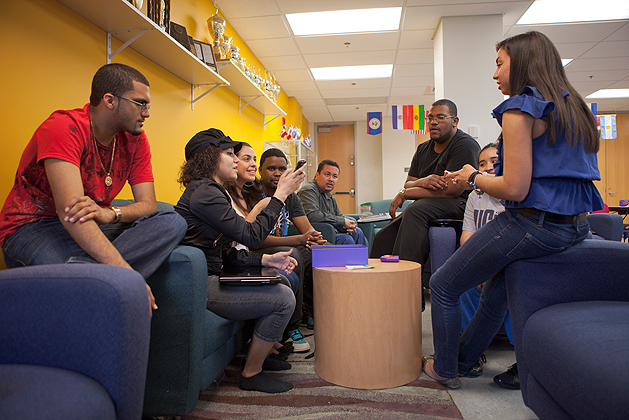
Growing up in a bustling, predominantly Puerto Rican neighborhood in Hartford, Abby Morales knew that settling in Storrs as a University of Connecticut freshman might be a bit of a culture shock.
But like many others in UConn’s growing population of Latino students, Morales ’11 (CLAS) says UConn’s social and academic offerings and its emphasis on celebrating diversity quickly made her feel at home.
UConn has experienced strong growth in the enrollment, retention, and graduation of Latino students over the past several years. Students, administrators, and others credit that trend to outreach programs to attract high school applicants, and on-campus social and academic offerings to help those new Huskies thrive.
“It’s a bit of a culture shock when you get to Storrs, but it’s all about getting really engaged and involved in everything the campus offers,” says Morales, who was involved in the Lambda Theta Alpha Latin sorority, the Puerto Rican/Latin American Cultural Center (PRLACC), BAILE (Bringing Awareness Into Latino Ethnicities), and several other groups.
“I wasn’t sure what to expect, but I definitely felt UConn was welcoming,” says Morales, who is using her degree in human development and family studies at the state Department of Social Services.
Latino students represent about 6 percent of UConn’s undergraduates at the Storrs campus. In 1986, they comprised about 2 percent.
They’re also staying and graduating in larger numbers than ever before. Four of every five Latino students who enrolled or transferred as freshmen were still students in their junior year as of fall 2011, and about 75 percent graduated in five years or less.
That’s a jump from 2006, when three-quarters of Latino students who had entered as freshmen were still enrolled as juniors – but only 55 percent stayed on to earn their diploma within five years or less.
“It’s been an effort on the part of many,” says Nathan Fuerst, UConn’s director of undergraduate admissions. “There are people all over UConn who are champions for the recruitment, retention, and graduation of underrepresented groups.”
Trends tracked by the University’s Office of Institutional Research show that the growth in Latino student enrollment and graduation isn’t limited to the Storrs campus.
The regional campuses also are attracting and retaining more Latino students, a fact attributed both to UConn’s outreach efforts and their proximity to large Latino populations in Connecticut’s cities. Latinos represent 13 percent of all students enrolled at the regional campuses, with the highest numbers being 17 percent in Stamford and 15 percent in Waterbury.
The numbers at Storrs and the regional campuses represent an intentional effort to reach out to Latino students, not just a reflection of the region’s growing Latino population, several UConn officials say.
They cite programs such as Upward Bound, which brings students from predominantly minority urban schools to UConn’s Storrs campus for a slew of academic and social offerings; PRLACC, a campus mainstay since 1972; and a growing number of professional and alumni networks.
PRLACC already is training this summer’s student orientation leaders so they can explain the center’s offerings to incoming freshmen, including those who are not Latino but are interested in Latino culture and the center.
“Our focus and mission is inclusiveness, and that means this isn’t just a Puerto Rican/Latin American Cultural Center,” says Robert Yanez, its interim director. “It’s a community center that’s open and welcoming to everyone.”
Although many students involved with PRLACC are of Puerto Rican or Mexican descent, Yanez says more than 20 countries are represented. The center’s annual Latin Fest is a major draw for students and alumni, and its METAS program (Mentoring Educating and Training for Academic Success) has won widespread praise for helping retain new students by pairing them with upperclassmen as mentors.
UConn officials say that just because the number of Latino students enrolling and graduating is increasing doesn’t mean they can be complacent and assume the hardest work is behind them.
In fact, the number of Latino students is growing as a percentage of Connecticut’s public school graduates, making it even more critical for UConn to offer culturally relevant, socially welcoming, and academically supportive programs.
“More and more, we need to position ourselves to attract and serve Latino students,” says Fuerst, the undergraduate admissions director. “They’re seeing students from their communities come here and be successful and graduate, and that’s really invaluable.”


